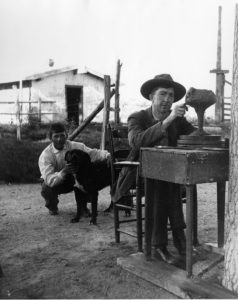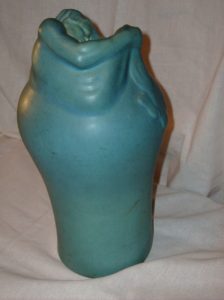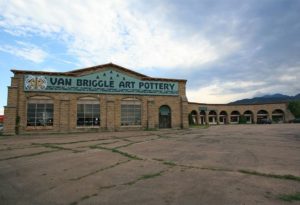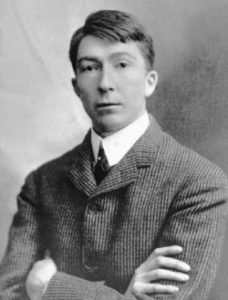On Exhibit Now: “Van Briggle: The Manitou Connection.” Come see one of the largest exhibits of Van Briggle pottery in the Pikes Peak region. Learn more about Artus and Anne Van Briggle’s connection to historic Manitou Springs. View dozens of beautifully designed pottery creations in our collection.
The Virtual Museum featuring Van Briggle Pottery
The Beginning of a Legacy
 Artus Van Briggle was born to artistic parents, who were of Dutch descent, in Felicity, Ohio on March 21, 1869. After moving to Cincinnati, Ohio in 1886, he started learning the craft of molding pottery at the world-famous Rookwood Pottery. During the spring of 1899, struggling with health issues due to tuberculosis, Artus Van Briggle left Rookwood Pottery in Cincinnati, Ohio and moved to the drier air of Colorado Springs. During 1899-1901, Van Briggle pursue his own styles of pottery and developed a matte glaze that that won him international acclaim and awards, including the Paris Salon (1903) for his “Despondency” vase . One of the glazes perfected by Artus was the matte blue, based on an ancient, lost Chinese process. He found rich deposits of kaolin and feldspar in Black Canyon near the Garden of the Gods and these elements together were used in creating the clay for his world-famous pottery.
Artus Van Briggle was born to artistic parents, who were of Dutch descent, in Felicity, Ohio on March 21, 1869. After moving to Cincinnati, Ohio in 1886, he started learning the craft of molding pottery at the world-famous Rookwood Pottery. During the spring of 1899, struggling with health issues due to tuberculosis, Artus Van Briggle left Rookwood Pottery in Cincinnati, Ohio and moved to the drier air of Colorado Springs. During 1899-1901, Van Briggle pursue his own styles of pottery and developed a matte glaze that that won him international acclaim and awards, including the Paris Salon (1903) for his “Despondency” vase . One of the glazes perfected by Artus was the matte blue, based on an ancient, lost Chinese process. He found rich deposits of kaolin and feldspar in Black Canyon near the Garden of the Gods and these elements together were used in creating the clay for his world-famous pottery.
After Van Briggle’s Death
 World-famous potter, Artus Van Briggle, died on July 4, 1904, at the age of 35. His wife, Anne, continued the pottery using the forms created by Artus as a foundation and adding more designs of her own. In 1907, Anne and pottery stockholder and city-founder General William Jackson Palmer began construction on a new pottery facility on Uintah Street. The Van Briggle Memorial Pottery, designed by Dutch architect, Nicholas Van den Arend, was opened in 1908 and stands today as an historic landmark noted for its architecture and use of ceramics in the facade. The land, which was located near Monument Valley Park, was donated by General Palmer. The Van Briggle Memorial Pottery is presently owned by Colorado College and is part of the college’s campus.
World-famous potter, Artus Van Briggle, died on July 4, 1904, at the age of 35. His wife, Anne, continued the pottery using the forms created by Artus as a foundation and adding more designs of her own. In 1907, Anne and pottery stockholder and city-founder General William Jackson Palmer began construction on a new pottery facility on Uintah Street. The Van Briggle Memorial Pottery, designed by Dutch architect, Nicholas Van den Arend, was opened in 1908 and stands today as an historic landmark noted for its architecture and use of ceramics in the facade. The land, which was located near Monument Valley Park, was donated by General Palmer. The Van Briggle Memorial Pottery is presently owned by Colorado College and is part of the college’s campus.
Relocation of Van Briggle
 The Van Briggle Memorial Pottery, located on Uintah Street, was devastated by flooding of Monument Creek on May 30, 1935. The onslaught of water crushed the walls of the Memorial Pottery and flooded the building to a depth of four to five feet. Although the flood destroyed much of the company’s records and molds, operations resumed soon afterward.
The Van Briggle Memorial Pottery, located on Uintah Street, was devastated by flooding of Monument Creek on May 30, 1935. The onslaught of water crushed the walls of the Memorial Pottery and flooded the building to a depth of four to five feet. Although the flood destroyed much of the company’s records and molds, operations resumed soon afterward.
The Van Briggle Art Pottery Company purchased the Midland Terminal Railroad Roundhouse in 1953 when it was thought Interstate 25 would be constructed in the same location as its Memorial Pottery on Uintah Street. After the Memorial Pottery was sold to Colorado College in 1968, all company operations were consolidated in the Roundhouse at the corner of 21st Street and US Highway 24.
The Manitou Connection
 American tastes in the 1950s turned to modern designs and all things glossy, so Van Briggle embarked on a new era which saw the pottery continue to produce the traditional matte glazes and Art Nouveau designs. The 1950’s also saw the introduction of more trendy gloss glazes and modern designs.
American tastes in the 1950s turned to modern designs and all things glossy, so Van Briggle embarked on a new era which saw the pottery continue to produce the traditional matte glazes and Art Nouveau designs. The 1950’s also saw the introduction of more trendy gloss glazes and modern designs.
In 1959, Kenneth Stevenson went to work for the Lewis brothers as their chief accountant for Van Briggle Pottery. Ten years later, the Stevensons bought the business from the Lewis’. The pottery continued to produce two distinct lines and enjoyed a period of expansion and relative stability under the production supervision of Fred Wills.
Kenneth was married to Bertha Newton, who had been born and raised in Manitou Springs. While Ken managed Van Briggle, Bertha played the viola in the Colorado Springs Symphony for 25 years. Ken and Bertha lived in Manitou until his death in 1990. Shortly after, Bertha Stevenson left the symphony and took on management of the company. With the help of one of her sons Craig A. Stevenson, who was by then Van Briggle’s chief designer, the pottery’s tradition continued. Bertha continued to reside in the Manitou Springs community until her death in 2010.

